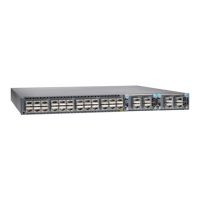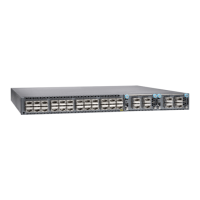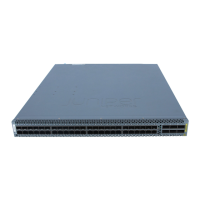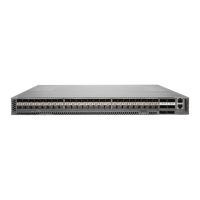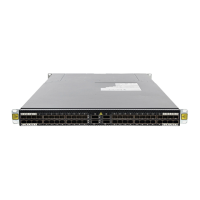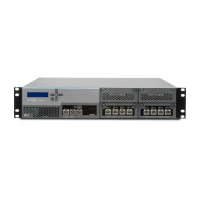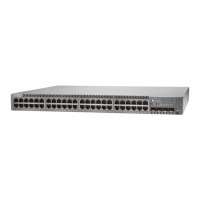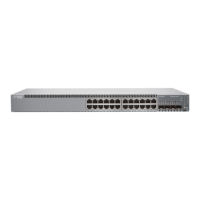Do you have a question about the Juniper QFX5110 and is the answer not in the manual?
Provides an overview of the QFX5110 switch capabilities and features.
Details the different QFX5110 switch models available, including port configurations.
Explains how power supplies and cooling systems provide redundancy.
Summarizes the physical dimensions and weight specifications for QFX5110 models.
Describes the port layout and capabilities of the QFX5110-48S model.
Details the port configuration and capabilities of the QFX5110-32Q model.
Explains the cooling system design, fan modules, and airflow directions.
Information on installing, removing, and LED indicators for fan modules.
Details the function and state of the fan tray LED indicators.
Information on AC power supply units, including airflow and installation.
Details DC power supply specifications, including dual feeds for resiliency.
Explains the status and fault indicators for AC power supplies.
Describes the input, output, and fault LEDs for DC power supplies.
Provides a checklist of tasks for preparing a site for QFX5110 installation.
Outlines environmental conditions and tolerances for QFX5110 operation.
Specifies the requirements for installing QFX5110 switches in racks.
Details the necessary clearance around the chassis for airflow and servicing.
Lists AC power consumption details for QFX5110 models.
Provides specifications for AC power cords used in different regions.
Lists DC power consumption and input ratings for QFX5110 models.
Guides on how to find supported optical transceivers for QFX5110 devices.
Details cable requirements for QSFP+ and QSFP28 transceivers.
Explains how signal loss factors affect fiber-optic connections.
Lists tested and supported USB flash drives for the QFX Series.
Provides pinout details for the RJ-45 console connector.
Details the pinout information for the RJ-45 management port.
Steps for installing and connecting the QFX5110 switch in a rack.
Instructions for safely unpacking the QFX5110 switch from its shipping carton.
Procedures for mounting the QFX5110 switch securely in a rack.
Guidance on planning and understanding VCF configurations for best results.
Details the process of connecting the QFX5110 to earth ground for safety.
Step-by-step instructions for connecting AC power to the QFX5110 switch.
Provides instructions for connecting DC power to the QFX5110 switch.
Explains how to connect a device for monitoring and management via a dedicated channel.
Guides on connecting a device to a console server or management console using an RJ-45 connector.
Details cabling and configuration for QFX5110 and QFX5100 members in a Virtual Chassis.
Illustrates cabling for QFX5110 devices in a Virtual Chassis Fabric (VCF).
Step-by-step guide for performing the initial configuration of the QFX5110 via CLI.
Instructions for installing a fan module into a QFX5110 switch.
Procedures for safely removing a fan module from a QFX5110.
Guides on how to install a power supply in a QFX5110 switch.
Steps for safely removing a power supply from a QFX5110.
Instructions for installing transceivers into QFX Series devices.
Procedures for removing transceivers from QFX Series devices.
Steps for connecting a fiber-optic cable to an optical transceiver.
Guidelines for proper maintenance of fiber-optic cables.
Overview of installing and removing field-replaceable units (FRUs) from QFX5110.
Instructions for safely powering off the QFX5110 switch.
Procedures for safely removing the QFX5110 switch from a rack.
Steps to follow when returning a QFX5110 or component for service.
Guides on how to find serial numbers on QFX5110 devices and components.
Instructions for packing QFX5110 devices or components for shipment.
Steps to create an emergency boot device for Junos OS recovery.
Procedures for performing a recovery installation of Junos OS.
Defines alarm terms and severity levels used for monitoring the device.
Lists chassis alarm messages, their types, and recommended actions.
Provides general guidelines to ensure safety and protect the device.
Explains the different levels of safety warnings used in the documentation.
States that only trained and qualified personnel should install or replace the device.
Guidelines for fire safety and the use of fire suppression equipment.
Emphasizes reading installation instructions before connecting to power.
Provides guidelines for safely lifting and moving the QFX5110 chassis.
Warnings and precautions for mounting the device in racks or cabinets.
Importance of grounding the device for safety during normal use.
Warns about avoiding exposure to radiation from open ports.
Specific laser and LED safety guidelines for QFX Series devices.
Warnings regarding the correct handling and disposal of batteries.
Advises against operating the device beyond the maximum recommended ambient temperature.
States that device disposal must follow national laws and regulations.
General guidelines for safe electrical practices when working with the device.
Guidelines to minimize potential damage from electrostatic discharge (ESD).
Safety guidelines specific to AC-powered devices.
Safety guidelines for DC-powered switches, including voltage and wiring.
Warning about the correct sequence for connecting and disconnecting DC power wiring.
Lists the safety and EMC standards the QFX Series complies with.
Details EMC requirements for the QFX Series by region (Canada, Europe, etc.).
Provides an overview of the QFX5110 switch capabilities and features.
Details the different QFX5110 switch models available, including port configurations.
Explains how power supplies and cooling systems provide redundancy.
Summarizes the physical dimensions and weight specifications for QFX5110 models.
Describes the port layout and capabilities of the QFX5110-48S model.
Details the port configuration and capabilities of the QFX5110-32Q model.
Explains the cooling system design, fan modules, and airflow directions.
Information on installing, removing, and LED indicators for fan modules.
Details the function and state of the fan tray LED indicators.
Information on AC power supply units, including airflow and installation.
Details DC power supply specifications, including dual feeds for resiliency.
Explains the status and fault indicators for AC power supplies.
Describes the input, output, and fault LEDs for DC power supplies.
Provides a checklist of tasks for preparing a site for QFX5110 installation.
Outlines environmental conditions and tolerances for QFX5110 operation.
Specifies the requirements for installing QFX5110 switches in racks.
Details the necessary clearance around the chassis for airflow and servicing.
Lists AC power consumption details for QFX5110 models.
Provides specifications for AC power cords used in different regions.
Lists DC power consumption and input ratings for QFX5110 models.
Guides on how to find supported optical transceivers for QFX5110 devices.
Details cable requirements for QSFP+ and QSFP28 transceivers.
Explains how signal loss factors affect fiber-optic connections.
Lists tested and supported USB flash drives for the QFX Series.
Provides pinout details for the RJ-45 console connector.
Details the pinout information for the RJ-45 management port.
Steps for installing and connecting the QFX5110 switch in a rack.
Instructions for safely unpacking the QFX5110 switch from its shipping carton.
Procedures for mounting the QFX5110 switch securely in a rack.
Guidance on planning and understanding VCF configurations for best results.
Details the process of connecting the QFX5110 to earth ground for safety.
Step-by-step instructions for connecting AC power to the QFX5110 switch.
Provides instructions for connecting DC power to the QFX5110 switch.
Explains how to connect a device for monitoring and management via a dedicated channel.
Guides on connecting a device to a console server or management console using an RJ-45 connector.
Details cabling and configuration for QFX5110 and QFX5100 members in a Virtual Chassis.
Illustrates cabling for QFX5110 devices in a Virtual Chassis Fabric (VCF).
Step-by-step guide for performing the initial configuration of the QFX5110 via CLI.
Instructions for installing a fan module into a QFX5110 switch.
Procedures for safely removing a fan module from a QFX5110.
Guides on how to install a power supply in a QFX5110 switch.
Steps for safely removing a power supply from a QFX5110.
Instructions for installing transceivers into QFX Series devices.
Procedures for removing transceivers from QFX Series devices.
Steps for connecting a fiber-optic cable to an optical transceiver.
Guidelines for proper maintenance of fiber-optic cables.
Overview of installing and removing field-replaceable units (FRUs) from QFX5110.
Instructions for safely powering off the QFX5110 switch.
Procedures for safely removing the QFX5110 switch from a rack.
Steps to follow when returning a QFX5110 or component for service.
Guides on how to find serial numbers on QFX5110 devices and components.
Instructions for packing QFX5110 devices or components for shipment.
Steps to create an emergency boot device for Junos OS recovery.
Procedures for performing a recovery installation of Junos OS.
Defines alarm terms and severity levels used for monitoring the device.
Lists chassis alarm messages, their types, and recommended actions.
Provides general guidelines to ensure safety and protect the device.
Explains the different levels of safety warnings used in the documentation.
States that only trained and qualified personnel should install or replace the device.
Guidelines for fire safety and the use of fire suppression equipment.
Emphasizes reading installation instructions before connecting to power.
Provides guidelines for safely lifting and moving the QFX5110 chassis.
Warnings and precautions for mounting the device in racks or cabinets.
Importance of grounding the device for safety during normal use.
Warns about avoiding exposure to radiation from open ports.
Specific laser and LED safety guidelines for QFX Series devices.
Warnings regarding the correct handling and disposal of batteries.
Advises against operating the device beyond the maximum recommended ambient temperature.
States that device disposal must follow national laws and regulations.
General guidelines for safe electrical practices when working with the device.
Guidelines to minimize potential damage from electrostatic discharge (ESD).
Safety guidelines specific to AC-powered devices.
Safety guidelines for DC-powered switches, including voltage and wiring.
Warning about the correct sequence for connecting and disconnecting DC power wiring.
Lists the safety and EMC standards the QFX Series complies with.
Details EMC requirements for the QFX Series by region (Canada, Europe, etc.).
| Model | QFX5110 |
|---|---|
| Power Supply | Dual, hot-swappable |
| Rack Units | 1U |
| Operating Relative Humidity | 5% to 90% non-condensing |
| Input Voltage | 100-240 VAC |
| Operating System | Junos OS |
| Layer Support | Layer 2 and Layer 3 |
| Virtual Chassis Support | Yes |
| Ports | 48 x 10GbE SFP+ |
| Jumbo Frames | 9216 bytes |
| Operating Temperature | 32°F to 104°F (0°C to 40°C) |
| Operating Altitude | Up to 3, 048 m |
| Management | CLI |
| AC Input Frequency | 50/60 Hz |
| Storage Temperature | -40°C to 70°C |
| MTBF | Consult Juniper documentation for specific values. |
